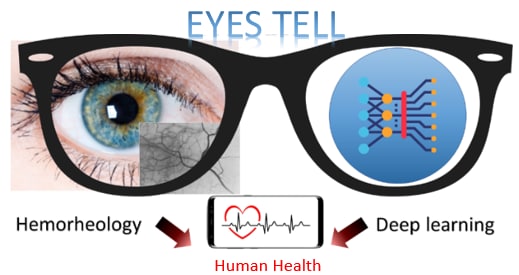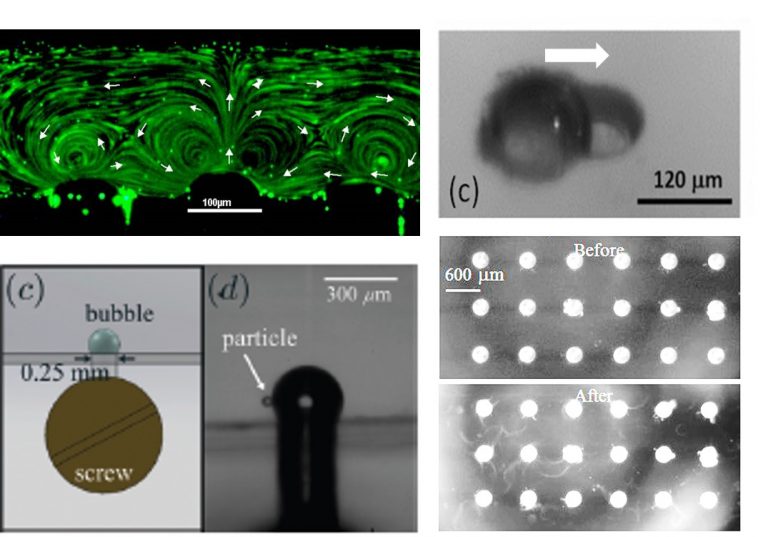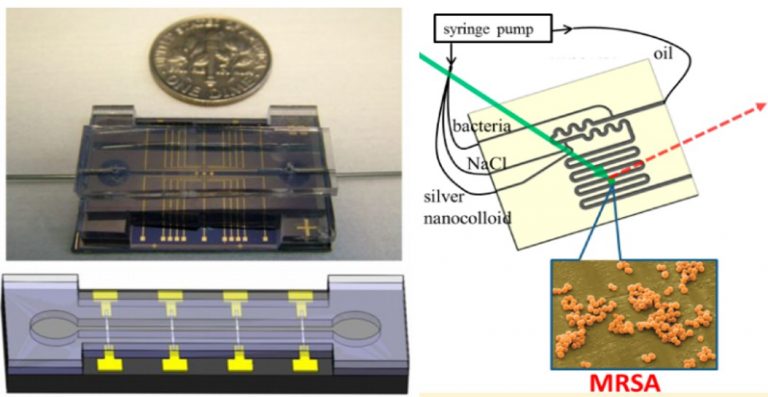In our daily life, we use eyes and ears to sense the world, and our hands to shape the world. However, if we want to understand and shape the world at microscale, we need help from miniaturized sensors and actuators. Our lab is focused on developing advanced microfluidic devices. Our recent interest is in understanding the blood flow pattern in the human eye and its implications on human heatlh.
EYES TELL (Eye based telemetry of microvascular erythrocyte rheology for human health) Heading link

“Eyes are the window to the soul.” The human eye has been shown by researchers to be a “window” to human health conditions. Indeed, our collaborators have shown that the blood flow pattern seen in the human eye is closely correlated to many diseases, such as stroke, cardiovascular diseases, renal failure, COVID, glaucoma, etc. In this research, we aim to engineer a wearable imaging system with integrated machine learning capabilities to tell human health conditions in real time through the eye.
Recent publications: Heading link
- B. Gaynes, M. B. Shapiro, A. S. Augustine, Y. Xu, Y. Lin, P. Mirbod, R. S. Dieter, Y. Cheng, M. Wu, H. Venkataraman, Y. Gao, P. Petrov, and J. Xu, Hierarchical data visualization of experimental erythrocyte aggregation employing cross correlation and optical flow applications, Microvascular Research, 2022, 143, 104386
- N. Patel, S. Duong, P. Mirbod, J. Xu, and B. Gaynes, A meta-analysis of variability in conjunctival microvascular hemorheology metrics, Microvascular Research, 2022, 142, 104340
- Y. Gao, M. Wu, B. I. Gaynes, R. S. Dieter, and J. Xu, Study of ultrasound thrombolysis using acoustic bubbles in a microfluidic device, Lab on a Chip, 2021, 21, 3707-3714
Acoustofluidics (bubble-based actuation) Heading link

The acoustofluidics research thrust in our laboratory explores interesting phenomena occurring when acoustic waves meet fluids at microscale. We are particularly interested in using acoustically-actuated microbubbles to create microstreaming, both symmetric (top left) and directional (top right), as well as creating a trapping force. Applications include microfluidic mixing, pumping, particle manipulation, worm/sperm sorting, fish manipulation, sensing enhancement, soundproofing, and additive manufacturing.
Recent publications: Heading link
- Y. Lin, C. Gao, Y. Gao, M. Wu, A.A Yazdi, and J. Xu, Acoustofluidic micromixer on lab-on-a-foil devices, Sensors and Actuators B, 2019, 287, 312-319
- P. M. Uribe, B. K. Villapando, K. J. Lawton, Z. Fang, D. Gritsenko, A. Bhandiwad, J. A. Sisneros, J. Xu, and A. B. Coffin, Larval Zebrafish Lateral Line as a Model for Acoustic Trauma. eNeuro, 2018
- D. Gritsenko, Y. Lin, V. Hovorka, Z. Zhang, A. A. Yazdi, and J. Xu, Vibrational modes prediction for water-air bubbles trapped in circular microcavities, Physics of Fluids, 2018, 30, 082001
- A. De Vellis, D. Gritsenko, Y. Lin, Z. Wu, X. Zhang, Y. Pan, W. Xue and J. Xu, Drastic sensing enhancement using acoustic bubbles for surface-based microfluidic sensors, Sensors and Actuators B, 2017, 243, 298-302
- Y. Chen, Z. Fang, B. Merritt, D. Strack, J. Xu and S. Lee, Onset of Particle Trapping and Release via Acoustic Bubbles, Lab on a Chip, 2016, 16, 3024-3032
- J. Xu and D. Attinger, Piezoelectric Actuation in Multiphase Microfluidics, Encyclopedia of Microfluidics and Nanofluidics, Springer, 2014
- Y. Xu, A. Hashmi, G. Yu, X. Lu, H.-J. Kwon, X.L. Chen and J. Xu, Microbubble array for on-chip worm processing, Applied Physics Letters, 2013, 102(2): 023702
- A. Hashmi, G. Heiman, G. Yu, M. Lewis, H.-J. Kwon and J. Xu, Oscillating bubbles in teardrop cavities for microflow control, Microfluidics and Nanofluidics, 2013, 14: 591-596
- A. Hashmi, G. Yu, M. Reilly-Collette, G. Heiman and J. Xu, Oscillating Bubbles: a Versatile Tool for Lab on a Chip Applications, Lab on a Chip, 2012, 12: 4216-4227
- G. Yu, X. L. Chen and J. Xu, Acoustophoresis in Variously Shaped Liquid Droplets, Soft Matter, 2011, 7, 10063-10069
Microfluidic biosensors Heading link

The biosensors research thrust in our laboratory focuses on cost-effective, user-friendly and reliable biological microfluidic chips to address various concerns in global health. Various sensing techniques and fabrication methods have been studied including electrochemical detection (left), optical detection (right) and 3D-printed microfluidic sensors. Specifically, ongoing research projects involve rapid biological detection based on paper devices, determination of foodborne pathogens based on DNA probes, early cancer detection by separating circulating tumor cells from blood samples and enzymatic/microbial electrochemical sensors.
Recent publications: Heading link
- Y. Lin and J. Xu, Paper-fluidic based sensing in food safety and quality analysis, Sensing Techniques for Food Safety and Quality Control, Royal Society of Chemistry, in press
- A. Yazdi, R. Preite, R. Milton, D. Hickey, S. Minteer and J. Xu, Rechargeable membraneless glucose biobattery: Towards solid-state cathodes for implantable enzymatic devices, Journal of Power Sources, 2017, 343, 103-108
- N. Lei, P. Li, A. Hashmi, W. Xue and J. Xu, Graphene Chemiresistors as pH sensors: Fabrication and Characterization, Graphene Science Handbook, Taylor & Francis Group – CRC Press, 2016, 309-318
- Y. Lin, D. Gritsenko, Q. Liu, X. Lu and J. Xu, Recent advancements in functionalized paper based electronics, ACS Applied Materials & Interfaces, 2016, 8(32), 20501-20515
- A. Yazdi, L. D’Angelo, N. Omer, G. Windiasti, X. Lu and J. Xu, Carbon nanotube modification of microbial fuel cell electrodes, Biosensors and Bioelectronics, 2016, 85, 536-552
- Y. Lin, D. Gritsenko, S. Feng, Y. C. Teh, X. Lu and J. Xu, Detection of heavy metal by paper-based microfluidics, Biosensors and Bioelectronics, 2016, 83, 256-266
- L. Guo, J. Feng, Z. Fang, J. Xu, and X. Lu, Application of Microfluidic “Lab-on-a-Chip” for the Detection of Mycotoxins in Foods, Trends in Food Science and Technology, 2015, 46(2), 252-263
- M. Aghaamoo, Z. Zhang, X. Chen, and J. Xu, Deformability-based circulating tumor cell separation with conical-shaped microfilters: concept, optimization and design criteria, Biomicrofluidics, 2015, 9, 034106
- J. Feng, C. de la Fuente-Núñez, M. Trimble, J. Xu, R. Hancock, and X. Lu, An In-situ Raman spectroscopy-based microfluidic “lab-on-a-chip” platform for non-destructive and continuous characterization of Pseudomonas aeruginosa biofilms, Chemical Communications, 2015, 51, 8966-8969
- C. Rivera, H-J Kwon, A. Hashmi, G. Yu, J. Zhao, J. Gao, J. Xu, W. Xue, and A. Dimitrov, Towards a dynamic clamp for neurochemical modalities, Sensors, 2015, 15(5), 10465-10480
- Z. Zhang, X.L. Chen, and J. Xu, Entry effects of droplet in a micro confinement: implications for deformation-based circulating tumor cell microfiltration, Biomicrofluidics, 2015, 9, 024108
- J. Chen, S. Feng, F. Gao, E. Grant, J. Xu, Q. Huang, and X. Lu, Fabrication of SERS-Active Substrates Using Silver Nanofilm-Coated Porous Anodic Aluminum Oxide for Detection of Antibiotics, Journal of Food Science, 2015, 80(4), N834-N840
- J. Xu, Microfluidics “lab-on-a-chip” system for food chemical hazard detection, Food Chemical hazard detection: development and application of new technologies, Wiley-Blackwell, 2014
- Z. Zhang, J. Xu, B. Hong and X.L. Chen, The effects of 3D channel geometry on CTC passing pressure – towards deformability-based cancer cell separation, Lab on a Chip, 2014, 14, 2576-2584
- X. Lu, D. R. Samuelson, Y. Xu, H. Zhang, S. Wang, B. A. Rasco, J. Xu and M. E. Konkel, Detecting and tracking nosocomial methicillin-resistant Staphylococcus aureus using a microfluidic SERS biosensor, Analytical Chemistry, 2013, 85(4): 2320-2327